Credit & Copyright: Matias Tomasello
Explanation:
The delightful Dark Doodad Nebula drifts
through southern skies,
a tantalizing target for binoculars toward the small constellation
Musca, The Fly.
The dusty cosmic cloud
is seen against rich starfields just south of the
Coalsack Nebula and the Southern Cross.
Stretching for about 3 degrees across the center of
this telephoto field of view,
the Dark Doodad
is punctuated near its southern tip (upper right) by yellowish
globular star cluster
NGC 4372.
Of course NGC 4372 roams the halo of
our
Milky Way Galaxy,
a background object some 20,000 light-years away and only
by chance along our line-of-sight to the Dark Doodad.
The Dark Doodad's well defined silhouette belongs to the
Musca molecular
cloud, but its better known alliterative moniker was first
coined by
astro-imager
and writer
Dennis di Cicco in 1986 while
observing Comet Halley from the Australian outback.
The Dark Doodad is around 700 light-years distant
and over 30 light-years long.
1999 2000 2001 2002 2003 2004 2005 2006 2007 2008 2009 2010 2011 2012 2013 2014 2015 2016 2017 2018 2019 2020 2021 2022 2023 2024 2025 |
Yanvar' Fevral' Mart Aprel' Mai Iyun' Iyul' Avgust Sentyabr' Oktyabr' Noyabr' Dekabr' |
NASA Web Site Statements, Warnings, and Disclaimers
NASA Official: Jay Norris. Specific rights apply.
A service of: LHEA at NASA / GSFC
& Michigan Tech. U.
|
Publikacii s klyuchevymi slovami:
globular cluster - dark nebula - temnaya tumannost' - Sharovoe skoplenie
Publikacii so slovami: globular cluster - dark nebula - temnaya tumannost' - Sharovoe skoplenie | |
Sm. takzhe:
Vse publikacii na tu zhe temu >> | |
